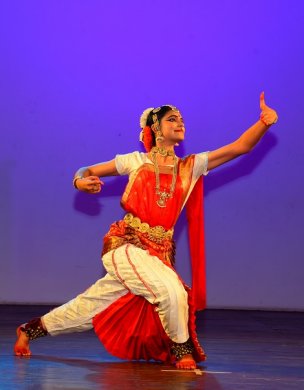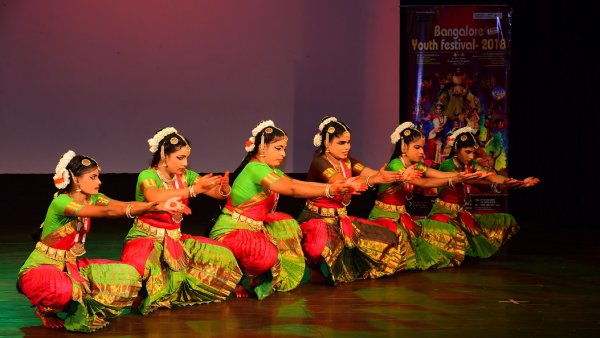
|   |

|   |
Samudra's youth festival - G Ulaganathan e-mail: ulag_nath@yahoo.com February 12, 2019 Veena Janardhan of Samudra Arts International from Thiruvananthapuram is passionate about dance and she has been organising dance festivals in many cities in India and abroad. She was not long ago based in Kuwait and started Samudra there. "Realising that Bangalore is almost becoming a dance capital of India with a lot of activities around the year and seeing the growing number of young girls and boys learning different styles of dance from various gurus, I wanted to hold the Bangalore Youth Festival exclusively for dance," she said while she put up a good show for two days at the Seva Sadan. With no help from local sponsors or organisations here, she was able to pull through with a lot of help and support from Bangalore based dancers like Deepa Pillai and her team. On the first day there was an interesting dance drama by the Chennai-based SACA creations, led by guru Seethalakshmi. Totally dedicated to Lord Ranganatha of Srirangam, the production called 'Boologa Vaigundam- Aranganin Srirangam' was spun around several interesting tales about Lord Ranganatha. It was a thematic presentation on the Srirangam temple as well narrating the history, its evolution and its various patrons. The first scene depicts Lord Ranganatha in his full glory during the month of Margazhi, showing how on the Ekadasi day the lord attired in special robes proceeds in a grand procession through the Paramapada vaasal. As he holds the grand durbar in the huge hall, Nalayira Divyaprabhandam is recited and he goes back to the temple only in the night. The scene was enacted with good props and the dancers attired in royal robes. In fact, costumes and devotional fervour pervaded the entire production. In one scene, it is revealed why the lord resides in Srirangam. In the celestial world, when Ganga and Cauvery fight over the issue of supremacy, Ganga becomes arrogant as she is cascading down Lord Shiva's hair. To the desperate Cauvery, Lord Vishnu offers the boon that he would come and reside on the banks of the river in Srirangam and the river will be blessed to wash his feet daily; also along with her tributary Kollidam, she will get a chance to flow like a garland around the island. There were a couple of more scenes woven around the story of Srirangam and the impressive presentation ends with Ranganathashtakam written by Adi Shankaracharya, with the last scene describing the daily rituals at the temple. Choreographed by Seethalakshmi, the lyrics, mostly in Tamil, were by Balaji Satyanarayan. Almost 26 dancers, including many small children, participated. 
Kavya Kasinathan
This was followed by a solo performance by one of Bangalore's leading young dancers Kavya Kasinathan. Trained by Mithun Shyam, she took to the stage after a long wait as the dance drama dragged on due to long explanation of each scene by the compere. Some of the scenes could have been pruned and edited to make the presentation more compact. Unfortunately the organisers did not enforce the time factor which was not fair on the three solo dancers scheduled to perform that day. Kavya was brilliant as she began with the Shiva Padam in Mayamalawagowla, composed by Muthu Thandavar. Kavya has a very flexible body and quick footwork and she knows how to use the stage fully. It was a delightful recital. The next performer Kshitija Kasaravalli is a disciple of gurus Geetha Ananthanarayan and B. Bhanumathy. She has mastered the karanas from the late guru Sundari Santhanam. She began with the Ranjani Mala Devi Stuti composed by Thanjavur Shankara Iyer and followed it up with the Madhurashtakam of Sripada Vallabhacharya. Both these young dancers did their gurus proud by sticking to traditional and conventional jati patterns. Then came the refreshing Kathak by the talented Shwetha Venkatesh and her team which included Nidhaga Karunad, Karthik B Shetty, Kshamitha Shastry and Asjhitha Rajesh Kumar. Beginning with the Vandana in teen taal, Shwetha spun a web with impressive choreography by Mysore B Nagaraj. She also paid tribute to late Guru Maya Rao by taking up her choreographic work for Tarana.  Articulate Ability On day two, it was a moving experience when six visually challenged children took the stage and presented a few Bharatanatyam numbers choreographed by Guru Dr. Suparna Venkatesh. The dancers were Lathamani G V, Nalina S, Anjali, Nandini, Sowndarya and Deepashree. Samudra intends to organise festivals where not only established artistes get a stage but also such children with physical disabilities but immense talent, says Veena Janardhan. Ulaganathan is a senior dance critic based in Bengaluru. |